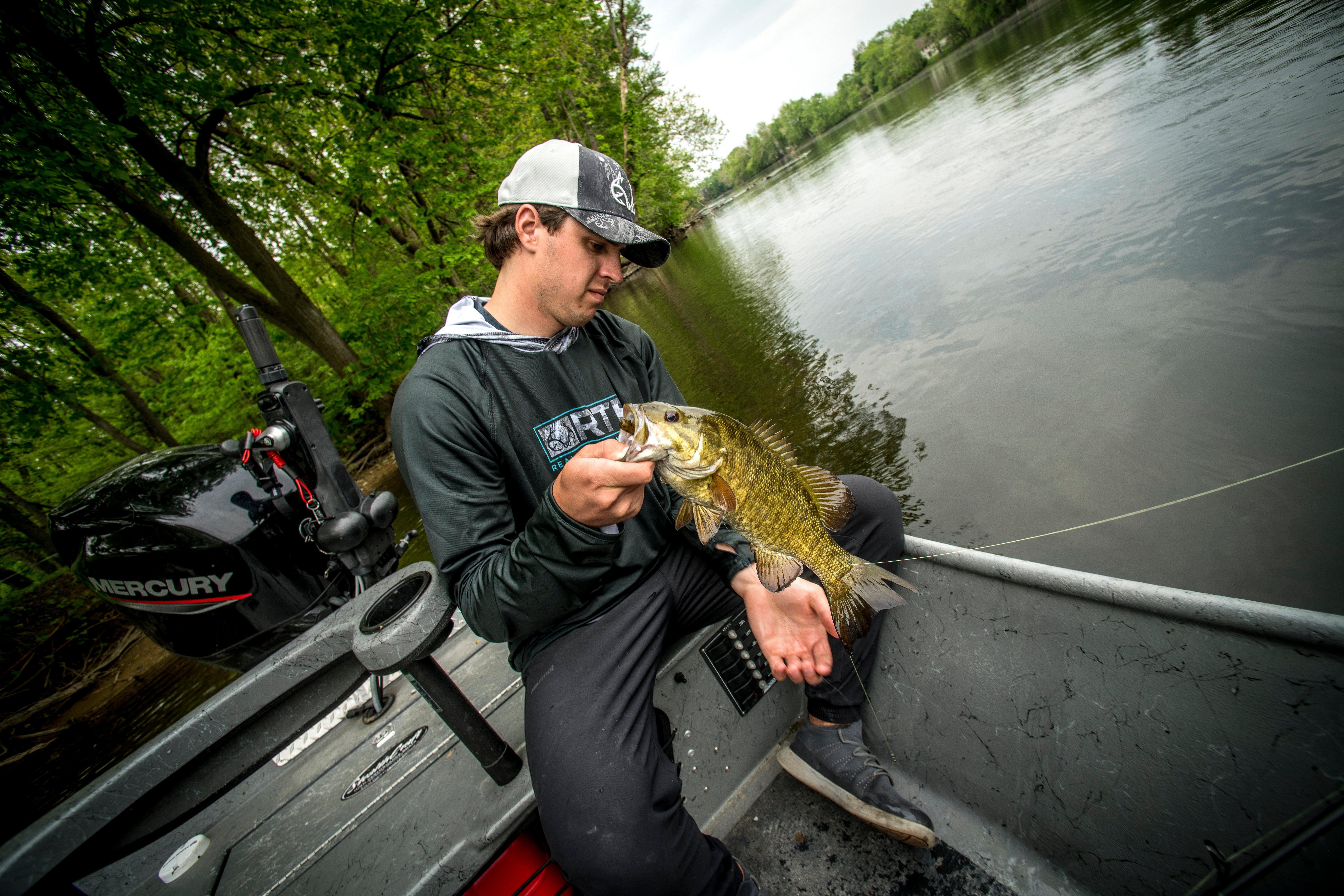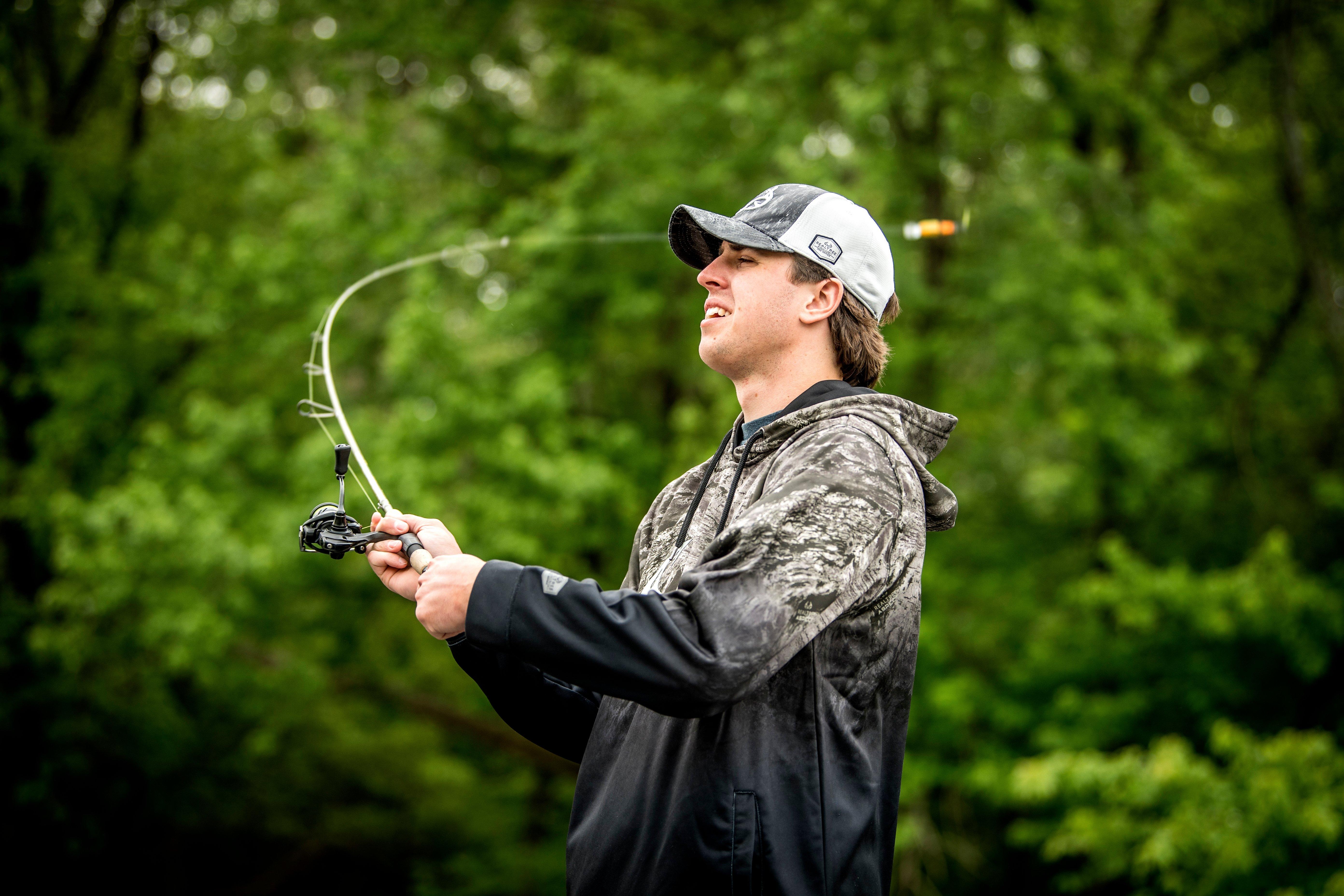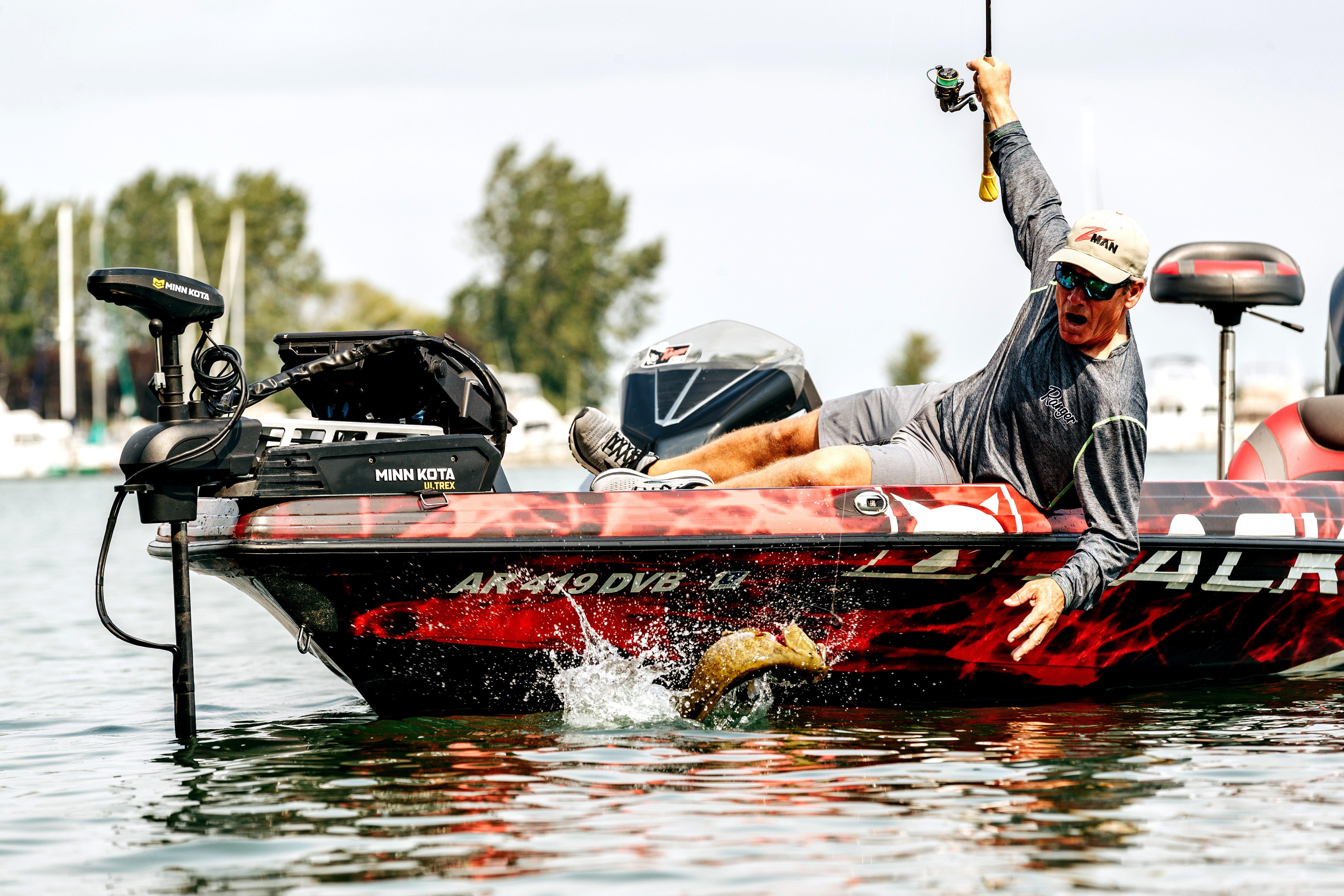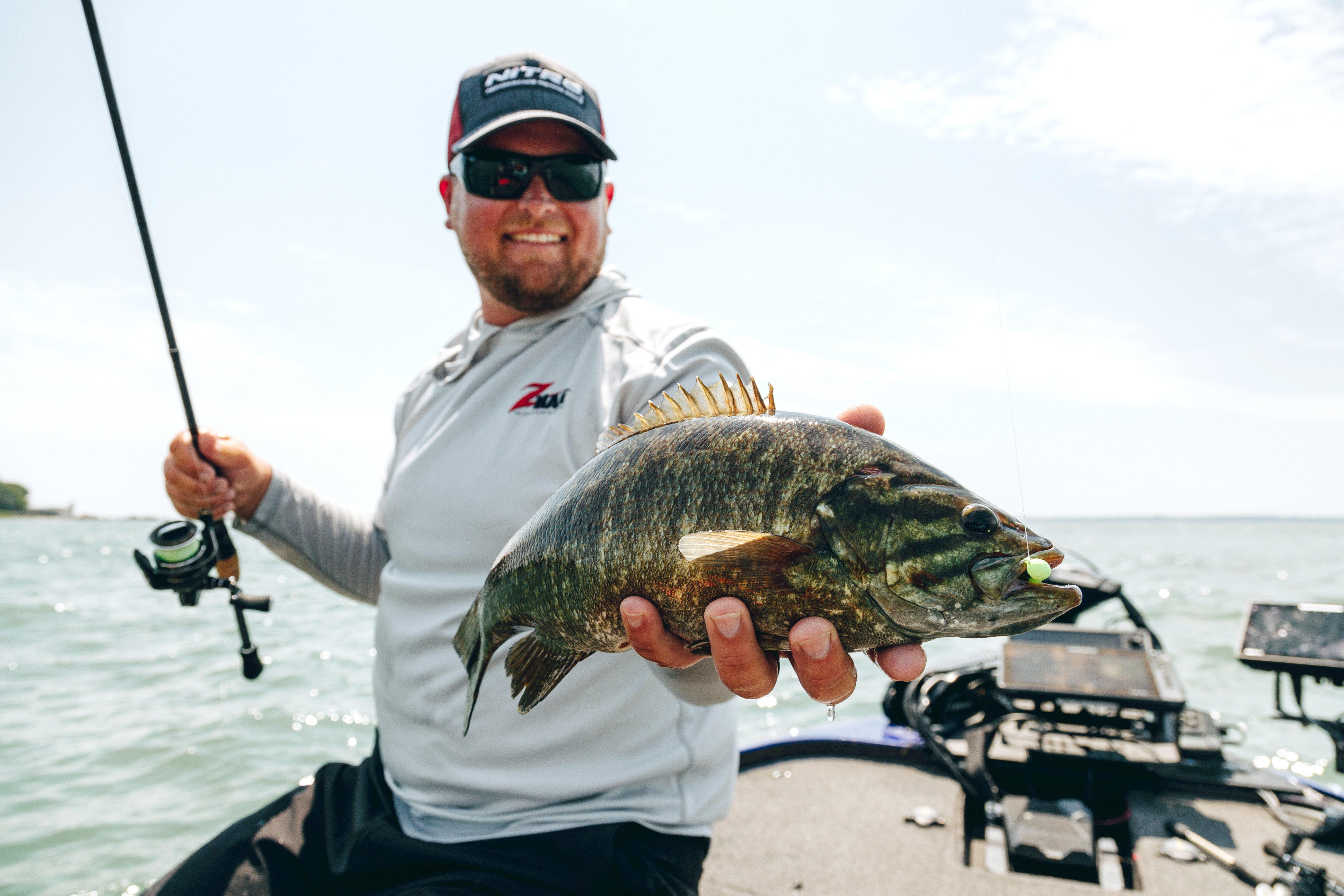Post-spawn fishing can be tough for bronzebacks, but the big ones are still out there if you know where to look

Post-spawn smallmouth fishing can be tough, but the bass are out there and still have to feed. (Photo by Bill Konway)
The good times are over. For months, smallmouth anglers have been chasing shallow fish, watching as they turn from lethargic Ned-rig slurpers to aggressive, jerkbait chompers. Noting beats pre-spawn in the smallmouth world, and this spring proved to be no exception.
But those days are behind us. With the rapid warm-up and summer vacation in full swing, the post-spawn smallmouth blues are a reality. Times are tough.
But do they have to be?
Inevitably, at your upcoming tournament, a pair of anglers will weigh a bag of smallmouth bass that would make anyone feel proud. But what does it take to find big fish this time of year?
I’ll let you in on a little insight. For 20 years, I chased some of the biggest smallmouths on the planet in the Great Lakes area. The fishing in June and July always proved to be tough, but once I figured out the recipe, post-spawn fishing went from 2-pounders to tournament winners. The key is in understanding the unique habits of brown bass.

During the post-spawn, head to known spawning grounds and then move out while looking for subtle depth changes and isolated structure. (Image by Bill Konway)
THE POST-SPAWN TRANSITION
The spawn is the most difficult time period in the year of a smallmouth bass. During every other season, smallmouths prioritize feeding. But during the spawn, a number of other household chores must be done, from nest building to defense and more.
While a lack of scientific evidence exists on smallmouth nesting cycles, it appears both male and female fish inhabit and defend their nests for longer than largemouth bass defend their nests. In addition, female smallmouths — those big fish we all drool over — often come out of spawning very lean.
Don’t Miss: Tips for Small Water Walleye Fishing
A noted rest period seems to occur for smallmouths following the spawn. Whereas big female largemouths are readily caught immediately after spawning, smallmouth bass seem more elusive and exhibit a lack of aggression.
The spawn seems to fatigue big smallmouth bass considerably more than other fish. While these are simple theories based on catch rates, it’s tough to argue that the bite gets tough in the post spawn, and large fish become increasingly scarce. This is when we’ll see mediocre limits win tournaments, leaving competitors scratching their heads. It’s as if the biggest fish left the lake.

After two decades of competitive angling in the Great Lakes area, the author learned some secrets for catching big smallies during the post-spawn. (Photo by Millennium Promotions)
THEY HAVEN’T LEFT THE LAKE
I can assure you that all the trophy smallmouth bass you’ve come to love are still in your favorite bodies of water. They just act a bit strange after the spawn. In order to score, we need to find concentrations of big fish, just like any other time of year. Start by heading to known spawning grounds, and then move out. You’re looking for the first subtle break-line or structure out from a spawning area. The presence of cover or objects will help, especially if they are large, singular items such as a group of pilings, a few boulders, a cabbage bed as big as your boat, or a break wall. A sunken item, like a rowboat, barrel, or swimming platform; now we’re talking. All of these spots will hold isolated, post-spawn smallmouths.
Let’s get specific, and talk water depths in your neck of the woods. On Lake St. Clair, this type of scenario would fall in 6 to 12 feet of water. On Erie or Ontario, it’s likely 12 to 20 feet. On the deepest clear-water lakes, it may be as deep as 25 feet. In fertile, inland smallmouth haunts, it could be as shallow as 5 feet.
Objects with some type of vertical profile seem to be best. It’s as if post-spawn smallmouths feel a sense of security from relating to a high profile. Perhaps it’s the shade that’s offered that attracts the fish, or maybe a forage type.
Tying in this “object” relationship was the biggest key I took away from two decades of chasing post-spawn bronzebacks. So secretive was the concept that I’m truly surprised to be letting it out of the bag now, even 10 years into tournament retirement.
Another key to location is a slight depth change. For post-spawn smallmouths, we’re not looking for big, drastic drop-offs and obvious rock piles. A subtle, sloping drop seems to be best. Again, using a real example of an area that I used to fish, this could be water dropping from 12 to 18 feet over the course of a hundred yards. Just a depression will sometimes do, but a change in depth of some form is important.
In essence, we’re looking for “bad looking” spots that most other anglers will avoid. These prove to be areas that, for some reason known only to the bass, smallmouths seem to gravitate toward, prior to moving to the more obvious structures of summer. Post-spawn locales are truly resting areas.

Post-spawn smallmouths act strange, but once you understand their habits and location, you can enjoy a successful day of fishing. (Photo by Millennium Promotions)
A BASS STILL HAS TO EAT
The stage is set. Big, lazy, post-spawn smallmouths are holding on isolated objects and gradually sloping drops. How does that affect your presentation and lure selection?
Again, remember that these are not the bass of summer. There will be no wolf-packs terrorizing small perch. Open-water baitfish are relatively safe. For the most part, these lethargic brown bass want an easy meal.
Crawfish seem to make up a big part of their diet. If your lake is a crawfish hotspot, look no further. The places that hold the craws will also hold the bass. While we’re all aware of the affinity crawfish have for rocks, there’s more to it than that. Sure, crawfish can be found in rocky areas, but there must be a food source for the craws, too, so sterile rock bottoms won’t work. A vegetation mix is essential, be it mosses or weedbeds.
Tall, vertical cabbage (potamogeton, or pond-weed) is a smallmouth staple across much of the North. This lines up with the presence of craws in areas where cabbage beds make an edge. There, you’ll often find gravel or rock, which is perfect habitat for numerous things smallmouth like to eat.
Don’t Miss: Secrets for Finding and Catching Readear Sunfish
This is a tube or jig-head-and-plastic game. Ned rigs work well, as do shakey-heads. You’ll want a bait that gets down and roots around in those transition areas where weedbeds meet open water. In deeper zones, a Carolina-rig can be productive.
The same scenario exists where boulders merge to chunk rocks, or clay to gravel around points. An edge is formed that is less than attractive to most fishermen, yet attracts invertebrates, small bait and crawfish, and is dynamite for recovering smallmouth. Remember, the presence of an object (maybe a buoy chain, or a moored boat) makes it even better.
Be on the lookout for groups of fish, and repeat your efforts in areas where you find success. Unlike other times of the year, it’s often important to continue to present a bait in the hot zone to receive successive strikes.
Afternoon warm-ups can trigger a faster bite, especially as evening approaches. Then, a jerkbait is hard to beat, especially a deeper, suspending model like a Rapala X-Rap or Deep Pointer. A fluke can score shallow, too.
In certain areas, large insect hatches occur this time of year. Mayflies come on in June, despite their name, and they represent an easy meal for gorging bass. Topwaters work well then, especially poppers, as do light grubs reeled below the surface. Break out the old inline spinner, if you can find one, and be prepared to be surprised.
Post-spawn smallmouth bass act strange, no doubt about it. But once you understand more about their habits and location, it’s easy to succeed and repeat the pattern throughout the lake, just like at other times of the year. Things are a bit more subtle, but the payoff comes to those who work the hardest.











































